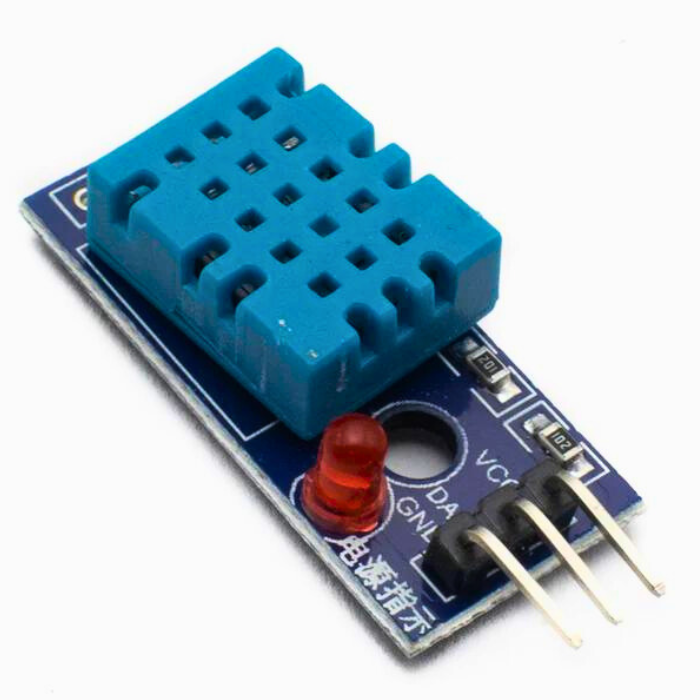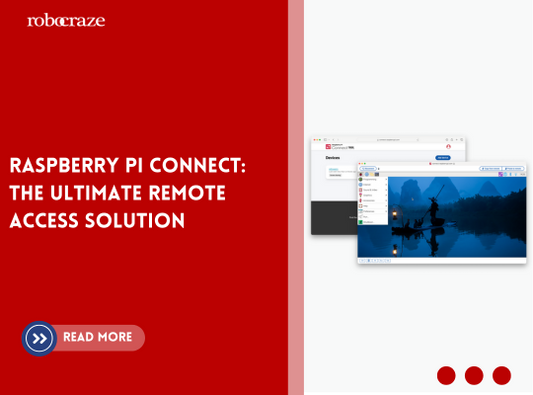In recent years, we have seen a tremendous growth in the usage of smart technologies to monitor plant growth and their health. A smart plant monitoring system uses advanced sensors, machine learning algorithms, and the Internet of Things (IoT) to collect real-time data on different aspects of a plant's environment and growth. This breathtaking technology enables farmers, horticulturists, and researchers to better understand the needs of plants, optimize their growth conditions, and detect early signs of disease or stress. These systems have the ability to monitor and control the growth of plant remotely anytime. With these features, we can say that smart plant monitoring system is indeed an efficient and sustainable approach in the field of agriculture.
In this tutorial, we will enrich ourselves with the details of smart plant monitoring systems, discussing their purpose, components, working, advantages over traditional systems, and other important aspects of this emerging technology.
Purpose of the system
The primary purpose of a smart plant monitoring system is to collect and analyze data related to the growth and health of plants. This plant health monitoring system can provide real-time information on environmental factors such as temperature, humidity, light intensity, soil moisture, and nutrient levels, which can have a significant impact on the growth of plants. By tracking these variables, smart plant monitoring systems allow us to make quick and informed decisions about the amount and timing of water and fertilizer applications, adjust the lighting or temperature, and take preventative measures to control pests and diseases.
Another critical purpose of the system is to detect early signs of plant stress or disease. The system can alert the people in charge about the issues such as nutrient deficiencies, water stress, or pest infestations, allowing them to take immediate actions before the problem worsens. This capability not only helps to reduce the risk of crop loss but also promotes more sustainable practices by minimizing the use of pesticides and fertilizers.
Overall, the main goal of the plant health monitoring system is to optimize plant growth and health while reducing waste and maximizing yields. By providing precise and timely information, this technology can help farmers, plant-enthusiasts and researchers to achieve more sustainable and efficient plant production practices.
Also, read our blog on the ESP8266 NodeMCU explaining what is ESP8266 NodeMCU and how to upload programs to ESP8266 NodeMCU.
Advantages :
There are numerous advantages of this plant moisture monitoring system. The important ones are pointed below:
- Increased efficiency: The real-time data about plant growth and environmental conditions can help to optimize the use of resources needed for the system such as water, energy, fertilisers, soil etc. This will lead to cut-costs and increase the savings. Also, this is proven to be a very sustainable approach for plant production.
- Better plant health: By detecting early signs of stress or disease, smart systems can aid to maintain and monitor healthier plants, which leads to higher yields and increase in the quality of the production. The need for chemical treatments is reduced dramatically thereby improving food safety and sustainability of environment
- More precise and targeted interventions: Smart plant monitoring systems enable us to make more informed and intelligent decisions about when and how to perform treatments such as fertilizers or pesticides. This can reduce waste and minimize the risk of over-applying chemicals, which can be harmful to the environment and human health.
- Remote monitoring and control: Remote monitoring helps us to maintain the health of the crops and make amendments from any corner of the world if we happen to have an internet connectivity. This method helps us to save our immense amount of time and reduce labour cost hugely.
- Improved data collection and analysis: These data provide valuable insights into the growth of plant and their environmental conditions which otherwise would be difficult enough without the involvement of Iot and sensors. Manually collecting these data for analysis is an exhausting task to achieve. This method helps researchers to develop new strategies for improving the production of plant and making their monitoring easier.
Building a prototype:
Component Required for Smart Plant Monitoring are given below
Project Hardware Used
Project Software Used
- Arduino IDE(for programming the ESP8266 NodeMCU board)
- Blynk App(for IoT control and wireless monitoring).
Circuit Diagram

The soil moisture sensor is attached to the NodeMCU's A0 analog pin. The NodeMCU's D4 pin (Digital pin) is linked to the signal pin of the DHT Temperature and Humidity sensor. The NodeMCU's D5 pin is used to connect the relay module. The water pump is further linked to the engine. The NodeMCU's D3 pin is linked to the LED. This serves as a source of illumination at night for IoT-controlled nighttime operations.
The NodeMCU always receives an analog signal from the DHT and moisture sensors, which it then uses to verify the temperature, humidity, and moisture levels.
Code:
#define BLYNK_PRINT Serial
#include
#include
#include
#include
#include
#define BLYNK_PRINT Serial
#include
#include
#define ONE_WIRE_BUS D2
OneWire oneWire(ONE_WIRE_BUS);
DallasTemperature sensors(&oneWire);
char auth[] ="----------------"; //Authentication code sent by Blynk
char ssid[] = "-------"; //WiFi SSID
char pass[] = "-------"; //WiFi Password
#define sensorPin D3
int sensorState = 0;
int lastState = 0;
#define DHTPIN 2
#define DHTTYPE DHT11
DHT dht(DHTPIN, DHTTYPE);
SimpleTimer timer;
void sendSensor()
{
float h = dht.readHumidity();
float t = dht.readTemperature();
if (isnan(h) || isnan(t)) {
Serial.println("Failed to read from DHT sensor!");
return;
}
Blynk.virtualWrite(V5, h); //V5 is for Humidity
Blynk.virtualWrite(V6, t); //V6 is for Temperature
}
void setup()
{
Serial.begin(9600);
Blynk.begin(auth, ssid, pass);
pinMode(sensorPin, INPUT);
dht.begin();
timer.setInterval(1000L, sendSensor);
Serial.begin(115200);
Blynk.begin(auth, ssid, pass);
sensors.begin();
}
int sensor=0;
void sendTemps()
{
sensor=analogRead(A0);
sensors.requestTemperatures();
float temp = sensors.getTempCByIndex(0);
Serial.println(temp);
Serial.println(sensor);
Blynk.virtualWrite(V1, temp);
Blynk.virtualWrite(V2,sensor);
delay(1000);
}
void loop()
{
Blynk.run();
timer.run();
sendTemps();
sensorState = digitalRead(sensorPin);
Serial.println(sensorState);
if (sensorState == 1 && lastState == 0) {
Serial.println("needs water, send notification");
Blynk.notify("Water your plants");
lastState = 1;
delay(1000);
//send notification
}
else if (sensorState == 1 && lastState == 1) {
//do nothing, has not been watered yet
Serial.println("has not been watered yet");
delay(1000);
}
else {
//st
Serial.println("does not need water");
lastState = 0;
delay(1000);
}
delay(100);
}
Method:
- The components should be connected as shown in the circuit diagram
- Download Blynk App on your Smartphone and click new project.
- Select the NodeMcu board and click on create.
- Add three gauges for display (temp, humidity and soil moisture)
- Soil moisture – Virtual 2 pin (V2) , value : 0-200 and set it on 1 second and do the same for temperature(V6) and humidity(V5) as well.
- Add a button and a timer.
- Navigate to the settings of the button and rename it as ‘Water’. Select digital pin 0 (D0) and select switch (slide the point to switch from push)
- Go to the settings of the timer and select D0. We can set the on and off time for the motor i.e the relay.
- Upload the code on the board after selecting the correct board and port on the Arduino IDE.
read our blog explaining the soil moisture sensor specifications, which provides comprehensive information about soil moisture sensors. It covers the importance of these sensors in agriculture and gardening.
Working of the project
The main agenda of the plant moisture monitoring system is to automate the process of monitoring and watering plants with the help of various sensors and microcontroller. The system uses NodeMCU ESP8266, which acts as the main controller and connects to Wi-Fi which enable remote monitoring. The soil moisture sensor measures the moisture level of the soil and it also helps us to determine if the plant needs watering or any other aid. The temperature and humidity sensors are used to measure the environmental conditions which is quite obvious from the names. These factors are equally important for the growth of the plant. The relay module is used to control the water pump and it ensures that the plant receives sufficient amount of water for their growth.
The plant moisture monitoring system continuously monitors the moisture level of the soil using the soil moisture sensor as stated above. If the moisture level goes down below a certain threshold, the NodeMCU ESP8266 immediately sends a signal to the relay module to activate the water pump. As a response, the water pump then supplies the needed amount of water to the plant.
In addition to this, the NodeMCU ESP8266 sends real-time data to a mobile or web application , allowing users to observe the plant's health and adjust the settings remotely (provided they have an internet connection with them). The user can set the moisture threshold, temperature, and humidity levels according to the plant's requirements.
Overall, the Smart Plant Monitoring System automates the process of monitoring and watering plants, making it easier for users to supervise of their plants. This system provides several advantages such as efficient water usage, real-time monitoring, remote access, and customized settings.
Conclusion
Smart plant monitoring systems are a revolutionary approach to optimize plant growth and improve overall crop yield and plant growth. With the use of NodeMCU ESP8266, soil moisture sensors, temperature and humidity sensors, relay modules, and water pumps, this system can effectively monitor and regulate the environmental factors that are crucial for plant growth. The benefits of this technology are myriad, including reduced water waste, increased crop yield, and improved resource management. The potentiality to remotely monitor, observe and control the plant growth environment is a game-changer in the agricultural industry and provides farmers with the necessary tools to optimize their crop growth while reducing the quantity of resources used without compromising with the quality even a bit. The implementation of smart plant monitoring systems is a step towards sustainable agriculture and has the potential to positively impact the environment, economy, and society as a whole.
If you appreciate our work don't forget to share this post and leave your opinion in the comment box.
Please do check out other blog posts about Popular electronics
Make sure you check out our wide range of products and collections (we offer some exciting deals!)










